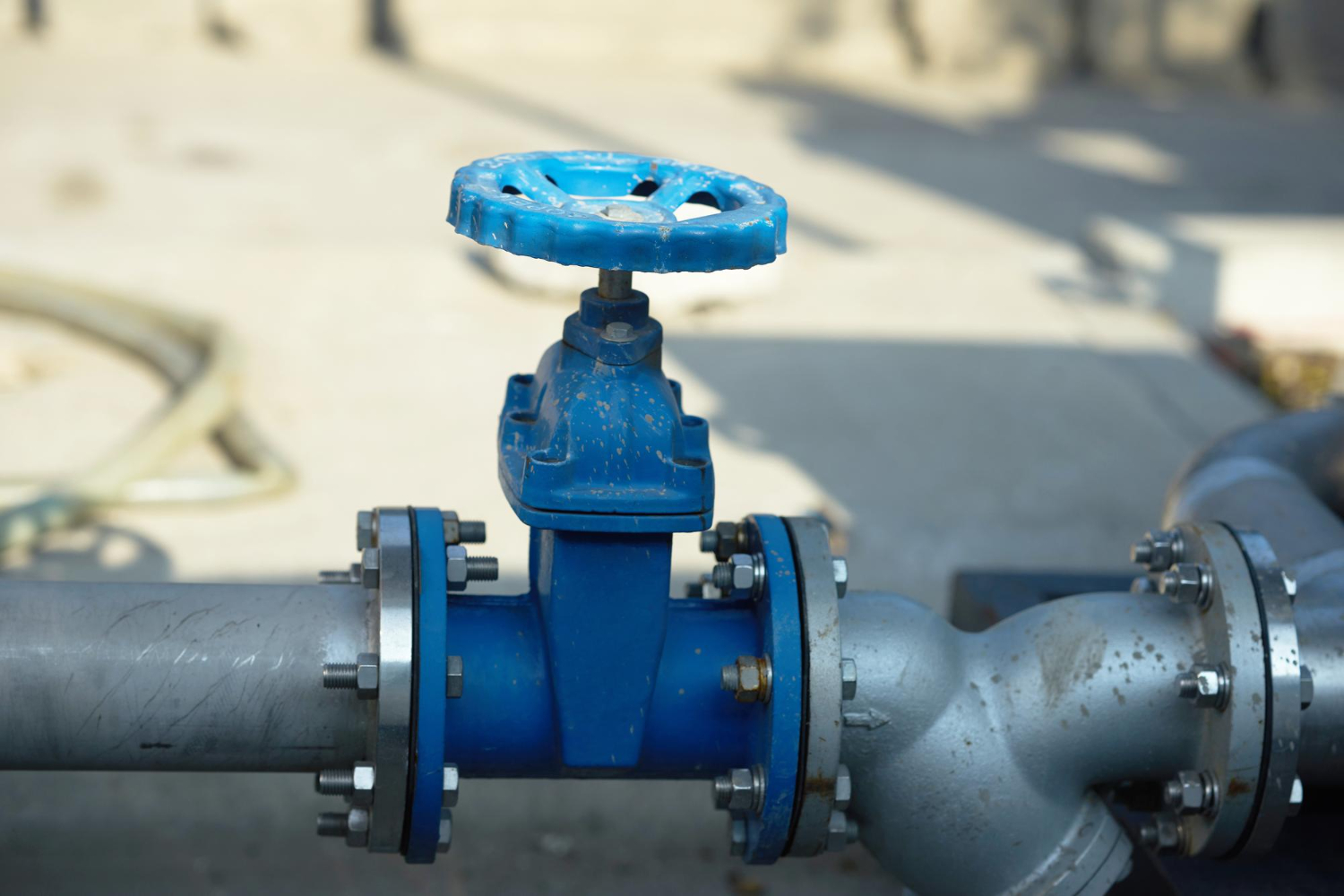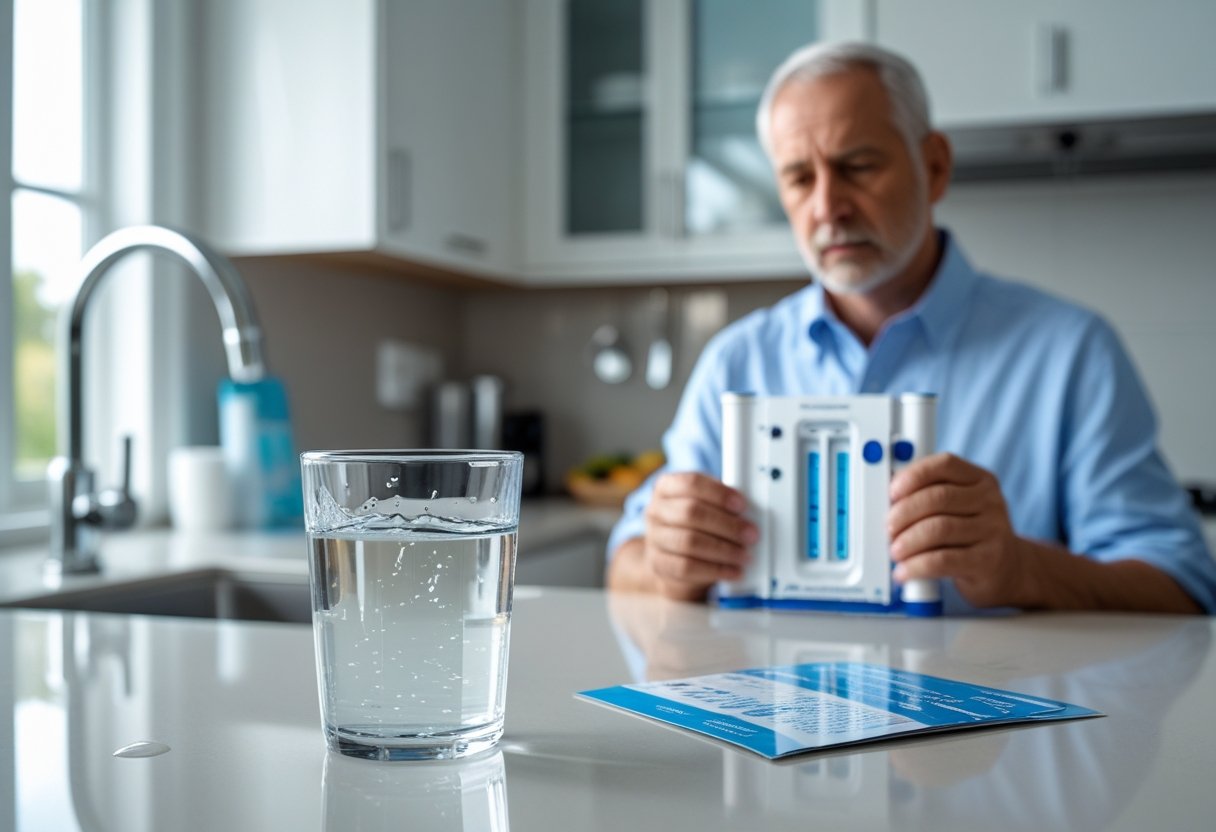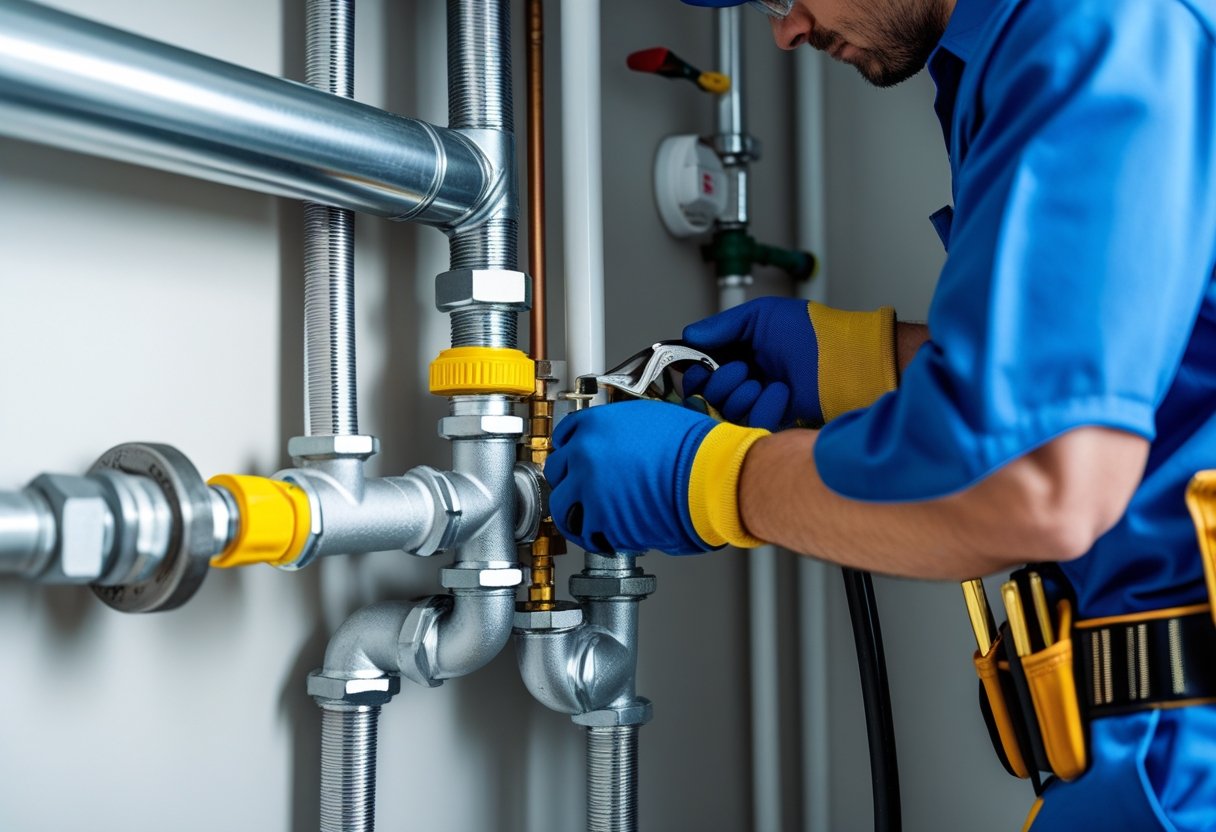Clean water is something we all take for granted until something goes wrong. Your home's water system faces constant threats from contamination and backflow that could put your family's health at risk. That's where dual check valves come in as your first line of defense.
A dual check valve works by using two separate check valves in series that only allow water to flow in one direction, preventing contaminated water from flowing back into your clean water supply. These spring-loaded valves automatically close when they detect reverse flow, giving you double protection against backflow events that could contaminate your drinking water.
The EPA’s Cross-Connection Control Manual explains that dual (double check) valves use two resilient seated check valves in series, each spring-loaded to seal tight and prevent both backpressure and backsiphonage. Test ports are often included for easy testing.
We'll walk you through exactly how these important safety devices work inside your plumbing system.
Here's what you need to know:
- What a dual check valve actually does
- Inside the mechanism: How a dual check valve works
- Choosing the best dual check valve for home use
- Maintenance and inspection of dual check valves
- Pacific Backflow's expertise with backflow protection
Keep reading! You'll learn what makes them different from single check valves, how to choose the right one for your home, and why proper maintenance keeps your water safe year-round.
What a dual check valve actually does
A dual check valve serves as a critical safety device that prevents contaminated water from flowing backward into clean water supplies. This backflow prevention system uses two independent check valves working together to protect both residential plumbing and commercial plumbing systems from potential contamination.
EPA guidance notes that residential dual check valves are simpler versions of double check assemblies, suitable for single-family home connections and intended for low-risk environments.
The core purpose behind dual check valve functions
The primary job of a dual check valve is backflow prevention. When water pressure drops in the main supply line, contaminated water can flow backward into the clean water system.
A dual check valve stops this dangerous reverse flow. It contains two separate check valves inside one housing. Each valve only allows water to flow in one direction.
If the first valve fails, the second valve provides backup protection. This redundant safety system ensures our potable water supply stays clean and safe to drink.
Water utilities often install these devices right after water meters. They act as a secondary layer of protection for entire water systems.
The spring-loaded design means both valves automatically close when backward pressure occurs. No electricity or manual operation is needed.
How it differs from single and double-acting valves
A single check valve has only one valve mechanism inside. While this provides basic backflow protection, it offers no backup if the valve fails.
Dual check valves contain two independent valves in series. This means if one valve gets stuck or breaks, the second valve still prevents contamination.
Double-acting valves work differently from dual check valves. Double-acting valves can control flow in both directions when operated manually or automatically.
Valve Type
Number of Check Valves
Backup Protection
Primary Use
Single Check
1
No
Basic backflow prevention
Dual Check
2
Yes
Enhanced water safety
Double-Acting
Variable
Depends on design
Flow control systems
Dual check valves are specifically designed for one-way flow protection. They cannot be opened manually like some double-acting valves.
Where dual check valves are typically installed
We find dual check valves most commonly installed immediately after water meters. Water utilities place them here to protect the entire distribution system.
Residential plumbing systems use dual check valves at service connections. This protects individual homes from contamination issues.
Commercial plumbing installations require dual check valves in several locations:
- Main water service entrances
- Before irrigation systems
- At cross-connection points
- In fire protection systems
Industrial facilities use these valves where process water might contaminate drinking water. Chemical plants and manufacturing facilities rely on this protection.
Dual check valves also appear in truck air brake systems. These prevent air from flowing backward through brake lines.
The valves must be installed in the correct direction. An arrow on the valve body shows proper water flow direction.
Inside the mechanism: How a dual check valve works
A dual check valve uses two separate check valves working together to control water flow and prevent backflow. When backpressure builds up, the internal seals activate automatically to protect your plumbing system from contamination.
The flow process explained step by step
Water enters the dual check valve through the inlet side under normal pressure conditions. The first check valve opens when forward pressure pushes against its internal components.
Forward Flow Process:
- Water pressure pushes the first valve disc open
- Clean water flows through the valve body
- The second check valve opens under continued pressure
- Water exits through the outlet to your plumbing system
Each check valve contains a spring-loaded mechanism that controls the valve disc position. The spring tension keeps the valve closed when no forward pressure exists.
The two valves work independently but in sequence. If water flow stops, both valves close automatically. This prevents any standing water from flowing backward into the supply line.
Key Components in Action:
- Valve discs: Open and close based on pressure
- Springs: Provide closing force when pressure drops
- Valve seats: Create tight seals when closed
How backpressure activates internal seals
Backpressure occurs when water tries to flow in the reverse direction. This happens during cross-connection events or when downstream pressure exceeds supply pressure.
When backpressure builds, it pushes against the downstream check valve first. The internal seals respond immediately by pressing the valve disc firmly against its seat.
The spring-loaded mechanism assists this sealing action. Higher backpressure creates stronger sealing force between the disc and seat.
Backpressure Response:
- Reverse pressure hits the second check valve
- Valve disc closes against its seat
- Internal seals prevent any backward flow
- First check valve provides backup protection
If the second valve fails, the first check valve still prevents backflow. This dual protection system makes these valves reliable for protecting water supplies.
Dual check valve diagram: Breaking down each component
We can understand the valve better by examining its main parts:
Primary Components:
- Inlet connection: Where clean water enters
- First check valve assembly: Initial flow control
- Test cocks: Allow pressure testing between valves
- Second check valve assembly: Backup protection
- Outlet connection: Where water exits to your system
The valve body houses both check valve assemblies. Each assembly contains a disc, spring, and seat arrangement.
Internal Check Valve Parts:
- Disc: Movable barrier that opens and closes
- Spring: Provides closing force
- Seat: Sealing surface for the disc
- Guide: Keeps disc aligned properly
Test cocks between the valves help us monitor performance. These small valves let technicians check if either internal valve is leaking.
The entire mechanism fits within a compact valve body. Most dual check valves are small enough to install in tight spaces within your plumbing system.
Choosing the best dual check valve for home use
The right dual check valve protects your home's water supply through proper materials, essential safety features, and cost-effective installation. Smart buyers balance upfront costs with long-term protection and durability.
Features to look for in residential systems
Redundant protection stands as the most important feature in any dual check valve system. We need two independent check valves working in series to ensure backflow prevention even if one valve fails.
Pressure ratings must match your home's water system requirements. Most residential systems operate between 40-80 PSI, so we should choose valves rated for at least 175 PSI to provide adequate safety margin.
Size compatibility directly affects installation success. Common residential sizes include 3/4-inch and 1-inch connections, which we must match to existing plumbing lines.
Test ports allow for annual testing required by most local codes. We should look for valves with easily accessible test cocks that water utility companies can use during inspections.
Approved certifications ensure compliance with local water safety standards. We need valves that meet ASSE 1015 or USC Foundation for Cross-Connection Control standards.
Comparing dual check valve price vs. protection
Budget options range from $50-$100 for basic plastic or brass units. These work well for low-risk applications but may need replacement every 5-7 years.
Mid-range choices cost $100-$200 and typically feature better materials and longer warranties. We get improved durability and often easier maintenance access at this price point.
Premium models run $200-$400 but offer superior materials like stainless steel components. These units often last 15-20 years with proper maintenance, making them cost-effective long-term investments.
Installation requirements add $150-$300 to total costs when we hire licensed plumbers. Some areas require professional installation for code compliance, which affects our overall budget planning.
The cost of water contamination cleanup far exceeds valve investment. We should view dual check valves as insurance against expensive water system problems.
Which materials ensure long-term performance
Lead-free brass provides excellent corrosion resistance and durability for most home installations. We prefer brass valves with at least 85% copper content for optimal performance in residential water systems.
Stainless steel offers superior longevity, especially in areas with aggressive water chemistry. We should choose 316 stainless steel for coastal areas or homes with high chloride levels.
Plastic valves work well for temporary installations or budget-conscious homeowners. We can expect 3-5 years of service from quality plastic units, though they're more vulnerable to temperature extremes.
Internal components matter as much as valve bodies. We need spring-loaded check discs made from corrosion-resistant materials like stainless steel or brass to ensure reliable operation.
O-rings and seals should be made from EPDM or Viton materials. These rubber compounds resist chlorine degradation and maintain proper sealing over many years of service.
Maintenance and inspection of dual check valves
Dual check valves require regular maintenance to prevent contamination and ensure proper water flow. Testing procedures help identify problems before they become costly repairs, while professional inspections keep systems compliant with local plumbing codes.
How to know when yours needs replacement
We can spot several warning signs that indicate our dual check valve needs replacement. Reduced water pressure throughout the system often signals internal component failure.
Visible water leaks around the valve housing show that seals have deteriorated. We should also watch for discolored water or unusual tastes and smells.
The valve makes strange noises during operation when internal parts wear out. Frequent backflow incidents mean the valve cannot properly prevent reverse flow.
Warning Sign
What It Means
Low water pressure
Internal blockage or damaged components
Visible leaks
Worn seals or cracked housing
Water discoloration
Contamination entering the system
Strange noises
Loose or damaged internal parts
Most dual check valves last 5-10 years with proper maintenance. We should replace them immediately if leak detection reveals continuous dripping or if backflow testing shows failure.
Common issues and how professionals address them
Debris buildup inside the valve chambers causes the most common problems. Professional technicians disassemble the valve and clean all internal components thoroughly.
Stuck check discs prevent proper sealing and allow backflow. We use specialized tools to free these components without damaging the valve body.
Worn spring mechanisms lose their tension over time. Professionals replace these springs during routine inspection procedures to maintain proper valve operation.
Corrosion affects metal components in older systems. We apply protective coatings or recommend upgrading to corrosion-resistant materials.
Backflow testers use pressure gauges to measure valve performance. They create controlled pressure differentials to ensure both check valves seal completely.
Scale buildup from hard water requires chemical cleaning solutions. Professional services remove mineral deposits that interfere with valve movement.
Why regular testing keeps your water system compliant
Water regulations require annual testing of dual check valves in most areas. The California plumbing code mandates certified backflow testers perform these inspections.
Valve testing involves checking both upstream and downstream pressure readings. We measure pressure drops across each check valve to verify proper operation.
Documentation proves compliance during health department inspections. We maintain detailed records of all testing dates and results.
Failed tests trigger immediate repair or replacement requirements. Systems cannot operate legally without functioning backflow prevention devices.
Compliance protects public health by preventing contaminated water from entering the supply system. Regular testing catches problems before they affect water quality.
Most jurisdictions require testing by licensed professionals only. We schedule annual inspections to avoid penalties and maintain our operating permits.
Pacific Backflow's expertise with backflow protection
Pacific Backflow brings decades of experience in cross-connection control and backflow protection to San Diego homeowners. We combine certified testing, professional installation, and local code compliance to keep your water supply safe.
Certified testing for all dual check valve types
We perform comprehensive testing on all dual check valve systems using state-approved equipment. Our certified plumber team follows strict protocols to ensure each valve functions properly.
Testing includes:
- Spring tension verification
- Seal integrity checks
- Flow direction confirmation
- Pressure differential measurements
We test both individual check valves within the assembly. This dual approach catches problems that single-valve testing might miss.
Our technicians document every test result. You receive detailed reports showing your system's performance and any needed repairs.
We schedule annual testing to meet San Diego requirements. Our reminder system helps you stay compliant without missing important dates.
Professional installation for optimal performance
We install dual check valves using proper sizing and placement techniques. Our team evaluates your water pressure and flow requirements before selecting equipment.
Installation process:
- Site assessment and planning
- Valve selection based on your needs
- Precise mounting and connection
- System testing and calibration
We ensure adequate clearance around valves for future maintenance. Our installations meet all local plumbing codes and manufacturer specifications.
We use high-quality materials designed for San Diego's water conditions. This approach reduces corrosion and extends valve life.
System upgrades receive the same careful attention. We can replace older backflow devices with modern dual check valve systems.
Helping San Diego homes stay safe and up to code
We stay current with San Diego's backflow protection requirements. Our knowledge helps homeowners navigate local regulations and inspection processes.
Our compliance services include:
- Code requirement explanations
- Permit assistance
- Inspector coordination
- Documentation management
We work with irrigation contractors and pool installers. This teamwork ensures new systems include proper backflow protection from the start.
We provide emergency repair services when dual check valves fail. Quick response prevents water contamination and code violations.
Our maintenance programs keep systems running smoothly. Regular service prevents costly repairs and ensures continuous protection for your family's water supply.
Conclusion
Dual check valves protect our water supply through simple but effective design. The two check valves work together to stop contaminated water from flowing backward into clean water lines.
We recommend installing dual check valves on main water lines. This creates a barrier between our drinking water and potential contaminants like fertilizers or chemicals.
Regular maintenance keeps these valves working properly. Check for leaks and test the valves according to local codes. Most areas require annual testing by certified professionals.
These valves offer reliable protection for homes and businesses. They prevent backflow caused by pressure changes in water systems.
Dual check valves are required by many building codes. They provide peace of mind knowing our water supply stays safe from contamination.
The investment in dual check valves pays off through protected water quality. We get continuous protection without complex systems or high costs.
Schedule professional testing or replacement of your dual check valve to ensure continuous water safety and compliance with local codes.











